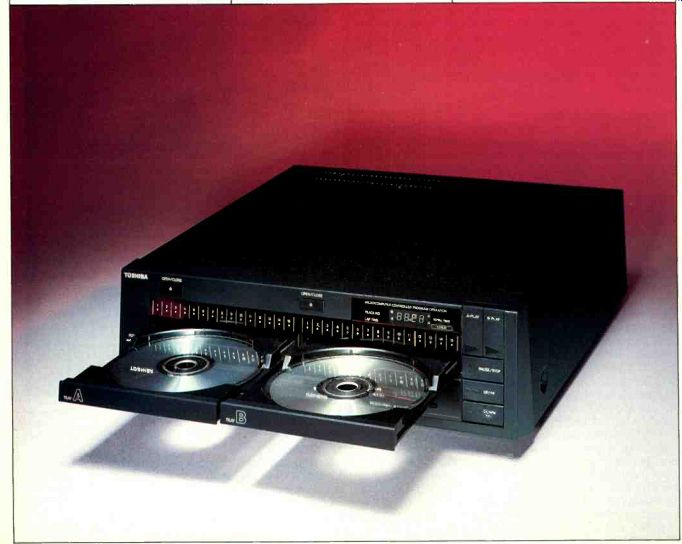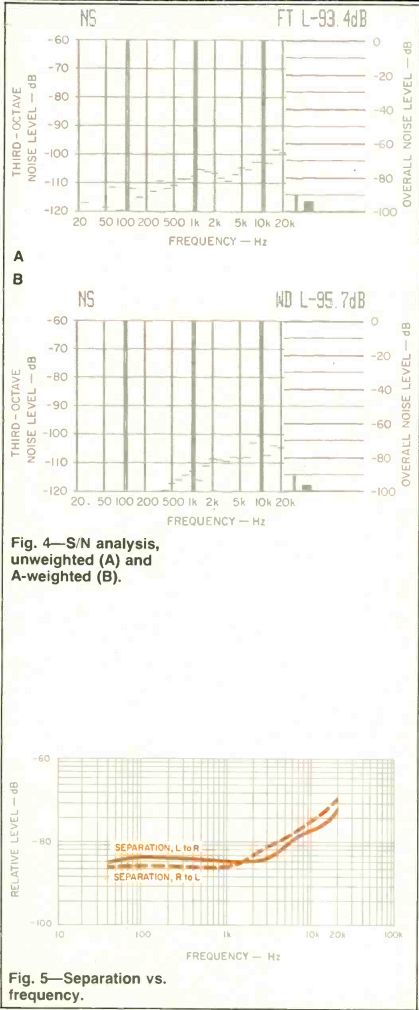
Manufacturer's Specifications
Frequency Response: 5 Hz to 20 kHz, ±0.5 dB THD: 0.003%.
Dynamic Range: 96 dB
Number of Programmable Selections: 30 (15 per tray).
Channel Separation: 90 dB.
Line Output Level: 2.0 V.
Power Requirements: 120 V, 60 Hz, 22 watts.
Dimensions: 13.4 in. W x 4.3 in. H x 14.25 in. D (34 cm x 10.9 cm x 36.2 cm).
Weight: 13.64 lbs. (6.2 kg).
Price: $499 Company Address: 82 Totowa Rd., Wayne, N.J. 07470.
I did a double take when I unpacked Toshiba's Model XR-V22. Perhaps taking a cue from the recent proliferation of double-well cassette decks, Toshiba has fashioned a double-tray CD player, one that can successively play two Compact Discs, or selected tracks from one CD followed by selected tracks from a second. But if you amateur disc jockeys (or even you professionals) out there are getting the idea that this novel arrangement will enable you to do with CDs what dual turntables allow you to do with LPs, forget it.
The Toshiba XR-V22 does not allow you to intermix cuts from the two discs mounted in its two trays-at least not in a preprogrammed way. Of course, you can play a single track from one disc, then a selected track from the other, but you have to do this manually if you want to continue to switch back and forth. You can program up to 15 selections in random order for each disc, but all 15 from one disc have to be played through before the machine will switch over to the alternate disc. So, in a sense, the Toshiba player is really a record changer of sorts, one with a capacity of two discs.
Furthermore, since the machine houses only one set of playback electronics (D/A conversion circuitry and stereo analog output circuitry), another popular DJ trick is not available to XR-V22 owners--fading from a cut on one disc to a cut on the second disc.
Some other convenience features now found on many similarly priced CD players are absent here. For example, it is not possible to program by index number. There is no audible fast search, and no remote control is provided.
Nevertheless, the XR-V22 is an interesting machine that I thoroughly enjoyed using and testing. If it is combined with Toshiba's SL-V11 stereo sound system (which includes their Model SK-V11 cassette deck/receiver), pressing the "Play" button on the CD player automatically switches the receiver's program selector to the CD/AUX mode. Synchronous recording from disc to tape is also possible when the player is used with the SL-V11 system.
Control Layout
The XR-V22's "Power" pushbutton is at the lower left of its front panel. Separate "Open/Close" buttons along the top of the panel activate the "A" and "B" disc drawers that slide out in the usual fashion. The drawers, positioned side by side, occupy most of the width of the panel; above each are 15 numbered LEDs. When a track is playing, a corresponding LED flashes on and off. During programming, the LEDs corresponding to the selected tracks illuminate continuously. When the machine is in the pause mode, an LED corresponding to the current track flashes rapidly. "A-Play" and "B-Play" pushbuttons that control the similarly identified trays are at the right end of the panel. A "Pause/Stop" button below these interrupts play if pressed once and discontinues play or programming if pressed a second time.
"Up/FF" and "Down/Rev" buttons, just below "Pause/Stop," perform dual functions. If either is pressed, the pickup advances or retreats one track at a time. If either is pressed while the "Play" button is held down, fast-forward or fast-reverse playing of the disc occurs.

Fig. 1-Frequency response, left (top) and right channels.
Fig. 2-THD vs. frequency at three signal levels; see text.
Fig. 3--Spectrum analysis of a 1-kHz signal (tall spike) shows small amounts of distortion at 2 and 3 kHz.

Fig. 4 -- S/N analysis, unweighted (A) and A-weighted (B).
Fig. 5--Separation vs. frequency.
A digital display near the top right of the front panel shows the number of the track being played, elapsed time within that track, or total elapsed time; display modes are changed with the "Display" button at the lower right of the panel. Ten numbered keys at the lower left are used in programming, with nearby "Memory A" and "Memory B" buttons determining whether the programming is intended for disc A or B.
The "Clear" button, just to the right of the memory controls, cancels any programming. A "Repeat" button just below the "Display" button toggles the repeat function on and off and can be used to repeat a single track, an entire disc, or even the two discs (or their selected program tracks).
In addition to the usual left- and right-channel output jacks on the rear panel, there is a multi-pin connector for a special supplied cable which links the player and Toshiba's cassette deck/receiver. It is this cable connection that allows the one-touch program selection and the synchronized re cording functions mentioned earlier.
Measurements

Fig. 6-Reproduction of a 1-kHz square wave.
Fig. 7-Unit-pulse test.
Fig. 8-Phase-error check using 2- and 20-kHz tones; see text.
Frequency response of the XR-V22, shown in Fig. 1, was flat to within the claimed ±0.5 dB over the entire audio range. Actually, it would be more accurate to say that the response was flat from 20 Hz to 20 kHz, +0,-0.8 dB. Note that the vertical scale in Fig. 1 is only 2 dB per division.
One surprising result of my tests was the relatively large amount of harmonic distortion observed for test frequencies at maximum recorded level. Normally, levels of THD below 0.01% are observed for such test tones, with harmonic distortion rising almost linearly as lower level signals are analyzed. Although certainly low by analog standards, the THD levels at 0-dB recorded level, plotted in Fig. 2, were higher than Toshiba's claimed 0.003%. Further investigation showed that these figures (typically 0.015%) were caused by familiar "analog" distortion. Apparently, the player's ana log output stages couldn't quite handle the high output voltage corresponding to maximum recorded level. They missed by no more than about 1 dB, for, when I lowered the test-signal level by that amount (I have a test track that offers signals at -1.0 and -6.0 dB relative to maximum output), THD dropped right down to about 0.005%. This figure is still not quite the 0.003% claimed, but it is certainly of the order I have come to expect from CD players.
The seemingly high harmonic distortion readings ob served when checking THD of high-frequency test signals (16, 19, and 20 kHz) are not really the result of harmonic distortion components. Rather, these higher readings (shown by the steeply ascending dashed lines beyond 10 kHz in Fig. 2) are caused by "beats" between the sampling frequency and the high-frequency test signal. Figure 3 con firms that this player produces some measurable harmonic distortion for a 1-kHz test signal. Just to the right of the tall spike (the desired 1-kHz test signal at maximum recorded level), you can see a small component of distortion at around 2 kHz and another, smaller component at 3 kHz.
Unweighted signal-to-noise ratio measured 93.4 dB; the A-weighted measurement was 95.7 dB, very close to Toshiba's claim of 96 dB for dynamic range. (See Figs. 4A and 4B.) SMPTE IM measured 0.013% at maximum recorded level, increasing to 0.027% at -20 dB recorded level. CCIF IM (twin-tone, using 19- and 20-kHz tones at the equivalent of highest recorded level) was a low 0.0057% at maximum recorded level and 0.0038% at -10 dB recorded level.
Stereo separation, plotted as a function of frequency in Fig. 5, ranged from 70.0 dB at the high-frequency extreme to 85.4 dB at mid-frequencies.
Reproduction of a 1-kHz square wave is shown in Fig. 6.
The wave shape indicates that Toshiba is using sharp-cutoff, "brick-wall" analog filters at the output of the player's D/A converters. The appearance of the unit pulse in Fig. 7, as reproduced from a Philips test disc, provides further evidence of steep analog filters at the player's output following D/A conversion. The phase error at high frequencies usually introduced by such brick-wall filtering is evident in Fig. 8, where 2- and 20-kHz signals are reproduced from the left and right channels of a special test disc. If no phase error were present, both signals would cross the zero axis in a positive-going direction at the same time. Figure 8 shows that when the low-frequency signal is crossing the axis in a positive direction, the higher frequency signal is crossing the zero axis in a negative-going direction. It is not possible to translate these results into an actual number of degrees of phase error or time delay, but it is clear that the error is at least 180° of the 20 -khz signal or a minimum of 25 uS. Of course, the error could be higher -75 µS (540° of a 20-khz signal) or even 900°.
Like a number of other CD players, the Toshiba unit had no trouble tracking through my simulated-defects disc, to tally ignoring the widest portion of the opaque wedge in scribed on that disc as well as the increasingly wide "dust" specks and the simulated fingerprint. Resistance to mild vibration and external shock was also excellent.
Use and Listening Tests
From my point of view, the advantage of the XR-V22 lies primarily in my being able to play a two-disc CD set without having to interrupt the music. I recently purchased the Deutsche Grammophon recording of Leonard Bernstein conducting his West Side Story--a most notable performance in which he uses operatic stars rather than Broad way singers. The drama of West Side Story is just about reaching its climax at the end of disc one, and it was nice to have disc two start playing without any interruption that would have broken the continuity and the dramatic intensity of the music.
As for sound quality, the reproduction achieved by the XR-V22 was acceptable, though I am becoming increasingly conscious of the sonic difference between CD players that utilize digital filtering and those that don't. Again, I would caution would-be DJs that this player, while cleverly designed and interesting in its own right, will not allow you to perform the tricks you have come to expect as standard with dual analog turntable arrangements. It will play two discs end-to-end (and repeatedly, if you wish) or selected tracks of one disc followed by selected tracks of another.
You can start with a disc in either drawer, but you can't flip back and forth from one to another, track by track, unless you program only one track per disc per drawer. Considering the price of the XR-V22, however, even the moderate amount of additional flexibility afforded by the two disc drawers certainly is a bonus over and above the more commonly found features on CD players in this price range.
-Leonard Feldman
(Source: Audio magazine, Apr. 1986)
Also see:
Phase Linear 9500 Compact Disc Player (Equip. Profile, June 1983)
NEC CD-803E Compact Disc Player (Nov. 1983)
Technics SL-P8 Compact Disc Player (April 1984)
= = = =